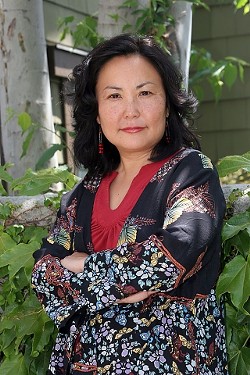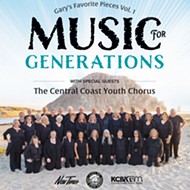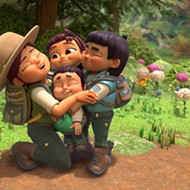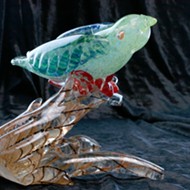Writing mysteries for social justice
The Central Coast Book and Author Festival returns
By Ashley Schwellenbach[{
"name": "Ad - Medium Rectangle CC01 - 300x250",
"id": "AdMediumRectangleCC01300x250",
"class": "inlineCenter",
"insertPoint": "8",
"component": "2963441",
"requiredCountToDisplay": "12"
},{
"name": "Ad - Medium Rectangle LC01 - 300x250",
"id": "AdMediumRectangleCC01300x250",
"class": "inlineCenter",
"insertPoint": "18",
"component": "2963441",
"requiredCountToDisplay": "22"
},{
"name": "Ad - Medium Rectangle LC09 - 300x250",
"id": "AdMediumRectangleLC09300x250",
"class": "inlineCenter",
"insertPoint": "28",
"component": "3252660",
"requiredCountToDisplay": "32"
}]
Naomi Hirahara, author of several non-fiction books, short stories, and a mystery series about a Japanese American gardener named Mas Arai, is a featured author at the Eighth Annual Book and Author Festival. Her work explores the challenges and experiences of Japanese Americans, and in the Mas Arai mystery series paints a portrait of a world of Japanese American gardeners in Southern California. She recently took some time to discuss her mystery series with New Times.
NEW TIMES Why did you choose the mystery genre for your first departure into fiction?
# HIRAHARA I've written short stories in the past, but in terms of novels, the Mas Arai series is the first for me. The first book in the series, Summer of the Big Bachi, actually took me about 15 years from idea to publication. It took a lot of different incarnations. I worked at a small newspaper, first as a reporter, then as an editor, and after I worked I took writing classes or worked on my novel early in the morning before I went to work. It was actually more of a literary novel. The character of Mas was there from the very beginning, but there was a second character a Japanese doctor, when it was a literary novel and it just didn't have enough oomph. Mas is a very reluctant protagonist and it needed more movement. I've always loved the mystery genre. A lot of African American mystery writers, like Chester Himes and Walter Mosley, who have written a lot about the black community in Los Angeles, influenced me in the sense that they walked beside me with their work and kind of showed me what I could do in terms of social history and revealing a certain ethnic group's subculture through the mystery genre. With the first book, my late grandmother was a survivor of the Hiroshima bombing and she had actually seen a body and drawn a picture and identified that person because they had a nametag. And a television station in Japan called NHK showed the picture and the relatives of that person were very grateful to see it. I don't know if I could use the word "closure," but it helped them to know that someone was aware enough to document this person's death. I know it sounds kind of bizarre. I thought that was so interesting that my grandmother had drawn that illustration and I thought, "You know, I want to put that in the book in some way." So that becomes a clue, this illustration. Then it became more of a murder mystery.
NEW TIMES There are currently three books in the Mas Arai series. Do you have any plans for a fourth?
HIRAHARA I do. I'm taking a small break. I have a middle-grade book for 10- to 14-year-olds coming out next year and it's not a mystery. And I'm currently working on a standalone mystery that's set in the '50s. But Mas has a cameo in there. But after that I want to resume the series. I just needed a little break just to grow as a writer and write from different points of view, especially because this is an older man and I want to write more from a female perspective.
NEW TIMES Mas Arai certainly isn't your average sleuth. How did he develop as your protagonist?
HIRAHARA I really wanted him to reflect this kind of curmudgeon person. All cultures have their resident curmudgeon, their uncle in the corner, but in the Japanese American culture I think Mas is more representative than, like, the nosy neighbor type. These people are trying to mind their own business, trying to get through each day as best they can. He is reflective of Japanese American history because there are these things that have happened, whether it be the forced removal of Japanese Americans from the West Coast, where they can't just mind their own business. This other thing has been imposed on them. So how are they going to react? And in the same way, things happen to Mas' close friends and family and he has to make a decision: "Well, what am I gonna do? Am I just going to sit back, or am I going to try to do something?" Probably a lot of us are reluctant to be witnesses and stand up and try to do something. I think, actually, Mas reflects a lot of us.
NEW TIMES You utilize a lot of odd nicknames in this series: Itchy, Stinky, Wishbone, Worm, Tug. Is that a coincidence, or are their names intended to say something greater about their personalities?
HIRAHARA A lot of Japanese Americans of that generation do have these funny nicknames. When I worked at the newspaper, one of our columnists was named Horse Yoshinaga and his column was "The Horse's Mouth." And when we ran obituaries, sometimes there would be like an older woman and in quotes it would say "Porky." And it's like, "What kind of person wants their obituary to say 'Porky' for their nickname?" But I think it was because some of their names were hard to pronounce and it kind of conveys their sense of humor. And also I do use it as a metaphor for who they are and sometimes it's ironic and sometimes not. In Tug's case, he's very reliable, like a Tugboat. And Wishbone, he's very unlucky. He's kind of the opposite of the luck represented by a wishbone. Because I have so many characters, I wanted to use as many unusual nicknames as possible so people can picture who these characters are.
NEW TIMES Your books frequently reference the Rafu Shimpo. Is that the paper you worked for?
HIRAHARA Yeah. Rafu is the old name for Los Angeles. Actually it was taken from Chinese characters, but the old newspaper's been around since 1903 and it still publishes today in Little Tokyo Los Angeles. When I was working there, the newspaper was published six days a week. Now it's five days a week. I think when you're working for a small newspaper there's a certain level of camaraderie. Our offices at the time were right on the border of Skid Row. It was a really interesting experience for me, being in my 20s and graduating from Stanford and being plopped into this world. I have great respect for people who work for small newspapers because you're not doing it for the money, obviously. You're doing it because you're committed to the community and the people that you serve and the readership. And the readership often feels great ownership of that paper as well. I wanted the newspaper to survive, so I figured any PR I could give them would help.
NEW TIMES There are a lot of frustrated translation efforts between Japanese and English, which are exceptionally challenging for characters trying to solve a mystery. Is that based on your observations of Japanese American culture or just a tool to further the mystery?
HIRAHARA The main characters, especially Mas and Harou, are kind of like people without a country because they are American citizens but they happened to be stranded over in Japan during World War II. They're not masters of any language. There are a group of people like that in the Japanese American culture, including my father, and I wanted to illustrate that experience and how people can often be creative in trying to figure out language. In a way they are kind of frustrated and thwarted because there are limitations, but in the end, because they are creative and insightful in their own way, they're able to figure things out.
NEW TIMES There seems to be a preoccupation with transportation in the series: descriptions of Mas' truck and the subway system in New York. Was there an underlying intention there?
HIRAHARA That's the first time anyone has asked me that question, which is really fascinating. It's so much of life in the big city. Cars mean much more than transportation in Los Angeles, so it was very intentional of me to pick a Ford an American car that Mas would drive, because it's supposed to illustrate his heart. He is an American. Even though he doesn't speak English well and he identifies with Japanese culture to some extent, he's still an American. So that's why he drives around with this beat-up car that no matter how beat up it is, it still works and that's kind of how Mas is. With mysteries, so much is based on movement and the character investigating and going from one place to another. When you talk about New York or L.A., transportation is key. Also, Mas in New York, he's going to take public transportation. He's not going to be taking taxis that often, and I think that's an important message.
NEW TIMES In several of the books you almost compare Hiroshima to 9/11 and Native Americans to Okinawans. What is the significance of these cultural reference points?
HIRAHARA No one's really ever asked me that question either, although it's very intentional. With most of these things, whether you talk about Hiroshima or 9/11, it gets so politicized and I wanted it to be a more personal story. Everyone's going to have a political take on what happened, but I wanted to get to the basics, like this thing did happen and it did affect people in a certain way. Sometimes there's a competition. It's like, "Well, this awful thing happened in this country" and "This awful thing happened in this country, and it was worse." And rather than taking that approach, when you survive something like this it allows you to have more empathy for people who have gone through the same things. I think that was the intention in mentioning 9/11. Mas has a special understanding or empathy for people who went through that. And a lot of these books are trying to point out the disenfranchised people. With the Okinawa thing, it's also to show that there is this very tenuous relationship between the Okinawa islands and Japan, so we're not just talking about Americans versus this country, but all countries wrestling with this issue of minority peoples.
NEW TIMES Do you do a lot of research about the history of Japan and Japanese Americans before you write?
HIRAHARA Summer of the Big Bachi was pretty much in my head. I had done a lot of research about Hiroshima and had read a lot of novels and interviewed people for other purposes for articles. So that stuff was more filed in my head. I had to do a little more research in terms of New York, but I've written nonfiction books, so I try to use a lot of the research I've done for nonfiction books for my fiction as well. The last book, I had to do the most research about Okinawa. The shamisen is a musical instrument, so I borrowed a lot of CDs of Okinawan music and before I started writing, whenever I was driving around here, I'd just listen to the CDs and kind of let the culture soak in. So it's not only this intellectual reading, but also kind of feeling the culture through music. And there are so many resources here in Los Angeles. I've been active with the Japanese American National Museum and there's a couple of Okinawa Associations. I talked to people and watched videos and things like that. But I think sometimes people can OD on the research and you always have to remember that this is a mystery so we can't get too bogged down in all these historic details. We have to be judicious in which ones we select or it's going to become a nonfiction book. And that has a slightly different goal than a mystery.
NEW TIMES As the series progresses, you seem to use more and more Japanese terms, as though you're slowly submerging readers into the culture. Was that your purpose?
HIRAHARA I wanted to take a snapshot of the Japanese American culture during a certain time. Already, as there's more intermarriage among Japanese and Americans, the stories are going to change. Our language is going to change. But I wanted to take a snapshot of this community that I had known here in L.A. during the '60s and '70s. I guess that's one reason it's taken so long for these books to be published. Now we've become so much more global, there's so much Japanese pop culture, like manga, in society. Kids are growing up eating sushi, which in my era the fact that we had sushi at certain family events was a great embarrassment to me, so things have kind of switched. I think our mainstream culture is more open than it ever was to new words. I get two responses to my books. Either it's like, "I never knew this world existed" and the other comment is, "Oh, that's my dad, that's my uncle, that's my grandfather, that's my neighbor, that's my gardener." So it's very interesting. It's like this parallel universe. It's like there is this society that exists, but a lot of people don't see it and don't know it exists. It's been closed to them and I'm kind of opening the door so people can see because I think the lessons these people have learned over the years have a universality to them.
NEW TIMES So is Mas' daughter, Mari, based on your own childhood experiences?
HIRAHARA I think the biggest difference between us is she is estranged from her father and I always have to say I am very close to my dad or else I couldn't have written this series of books about a character like him. He would still be an enigma to me.
NEW TIMES Especially in Snakeskin Shamisen, government figures are avoidable, at best. Is this just for the sake of the mystery, or do you feel that for minorities American authority figures aren't always looking out for their best interests?
HIRAHARA Judging from the past, in terms of this group of people, the government has made decisions that have tried to thwart their progress in this country. So, I think that since we are Americans, we need to be active in our society. We need to be active participants and active observers of things that come up, of policies. We need to be as honest and factual as possible. It's important to see how minorities have been treated during tumultuous times of our nation's history just as a reminder that these things kind of reverberate. Our country is built upon democratic values and we always have to remember that and we can't take it for granted. In Snakeskin Shamisen, there are police officers that are helpful, so it's not a totally black-and-white situation where anyone in authority is evil. I think that the message is that people need to be steadfast and people need to be exposed to the full story and maybe they need to do a little research on their own and make inquiries rather than accept things at face value.
NEW TIMES Are you a green thumb?
HIRAHARA No, I'm not. I kill plants. It's really awful. I'm so proud because I think I have like three living plants in my house. I've kept some alive for like four years. It's really ironic. But I have a great appreciation for gardens, and I love visiting botanical gardens when I travel. I think my parents dissuaded us. They didn't want my brother and I to follow in my father's footsteps. I was told more to study, so this is what happens.
NEW TIMES Why did you choose to portray Southern California and New York almost as characters?
HIRAHARA A lot of these cities kind of have these personifications, they start to have a human quality to them. I have a great respect for geography and place, as well as the history, the prior events that happened in that place. And I think there is some kind of residue that exists because of the people that have lived there before I think they're like layers. We talk about sedimentary layers, and I think there are layers to a place. It doesn't foretell the future because I think people can change the nature of a place, but it does point it in a certain direction. The way cities are laid out, whether we decide to preserve old buildings or not, those are human decisions. And it's often interesting why people choose to live in certain places. It's because of their past experiences. Maybe they lived in a very urban area and want to get away from the blight so they want to go to a very pristine, beautiful serene place. All of those things are so fascinating, and I love American cities.
NEW TIMES Have you been to the Central Coast before?
HIRAHARA Oh yeah. We've been to the Farmers' Market. My husband's really into college towns and colleges, so we've gone through the campus a bunch of times. And I've participated in the Obon. It's like a Japanese Buddhist festival. And this is before my mysteries came out, because one of the nonfiction books I wrote was about this businessman from Guadalupe. I had to interview a lot of people in the area. He eventually went on to found Mikasa Chinaware and Kenwood Electronics. I just find that area so interesting. I've been in touch with the Japanese community in San Luis Obispo, and I've done a lot of research on the farming of that area.
NEW TIMES Do you have a special writing process and space?
HIRAHARA Because I was trained as a journalist, I learned that I could write under practically any situation. I do have a little window seat where I write with my laptop. Because I'm a writer, a lot of people give me journals. For each project I select the right journal. That's where I start writing my notes, planning the characters. Through that, the story starts to grow. Once I see that and the characters, then I can start writing. So much of writing is more the execution of it, it's what you, with your individual voice, are going to bring to the plot.
INFOBOX: A real page-turner
The Central Coast Book and Author Festival takes place Sept. 8 from 10 a.m. to 4 p.m. in Mission Plaza. The festival will feature celebrity authors, readings and workshops, children's story time and crafts, book sales and signings, food, and more. Naomi Hirahara will be speaking on the Los Angeles noir panel at 11:15 in the Art Center's Gray Wing gallery, signing her books at the Novel Experience booth at 1 p.m., presenting in the community room at 2 p.m., and signing again at the Novel Experience booth at 3 p.m. For more information, visit www.ccbookfestival.org or www.naomihirahara.com.
E-mail Arts Editor Ashley Schwellenbach at [email protected].











